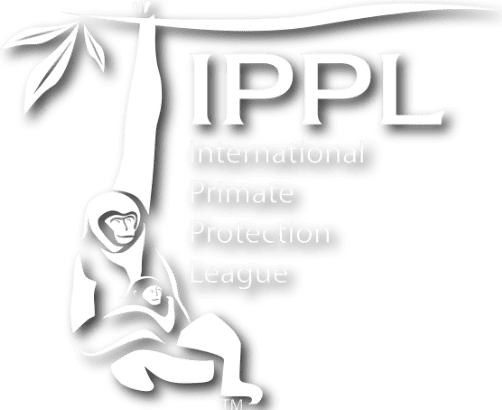Remembering Hurricane Hugo

Now is the peak of the hurricane season. Hurricane Isaac, a Category 1 storm with winds around 70 miles per hour, struck Louisiana this week.
This brought back memories of IPPL Headquarters being slammed by Hurricane Hugo, a Category 4 storm with steady winds of 135 miles per hour and gusts of up to 175 mph, on the night of 21-22 September 1989.
The Weather Channel told us that Hurricane Hugo would make landfall at Savannah, Georgia, 90 miles south of Summerville. But then it changed course and took a more northerly route.

Hurricane Hugo, headed right for us.
All IPPL gibbon enclosures, designed by John McGreal, had been built to be extremely strong. As the forecast started to look grim, three large, strong young men from the Summerville High School football team came to help us get ready. They helped add hurricane tie-downs to all the gibbon houses (galvanized steel bands that are placed across the roof of a building, sunk deep into the ground, and tightened up with a wrench). All windows of the gibbon houses, the human residence, and the office (then under construction) were boarded up with plywood. Supplies such as flashlights and batteries as well as human and animal food were collected.
On the night of 21 September, all the gibbons went into their indoor units for the night, as they do every night. Their concrete block houses were stronger than our own brick-veneer residence! The eight Asian otters living in pens in the woods were netted, placed in separate crates, and brought into our home, which soon began to smell awful. Not to mention the otters’ constant noisy complaints that they wanted more food!
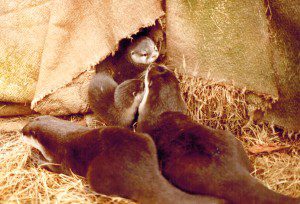
Rounding up all eight otters was quite a task!
Once it was certain we were going to be hit, we went around to have what we feared might be a last visit with our gibbons. At the time, these were: Arun Rangsi and Shanti and their kids Ahimsa and Elsa; Tong and Brownie; Sapphire and Durga; Helen and Peppy; Baby and Blythie; Blackie and Penny and their infant daughter E.T.; Igor; and young Elizabeth.
Soon after preparations were completed, the winds started to blow. They grew stronger and louder. At 8:30 p.m. the power went down. No lights, no Weather Channel! Only one old-style phone was in the house, and, around midnight, my twin sister Jean called to tell me that the eye had hit Charleston and Summerville. A few minutes later, this phone also went down.
The winds became ever stronger. We heard trees falling and objects flying through the air. Then the winds suddenly stopped. There was an eerie silence; the eye wall was passing right over our property. It would not have been safe to go outside during this 20-minute lull. An object such as a drinking straw flying through the air at 150 miles an hour can impale a person. Then we heard a huge crash, and the eye-wall winds, the strongest storm winds, suddenly rushed in. The hurricane continued for several more hours.
Because the storm was moving rapidly, the winds had slowed down by 6:30 a.m., and we felt safe venturing outdoors. At first it was hard to orient oneself—so many trees and branches and piles of junk lying around meant that familiar landmarks didn’t help. I collected several heads of romaine lettuce to deliver to the gibbons.

Shanti cuddled her little daughter Elsa.
Climbing over fallen trees and branches, I made my first stop at the house where Arun Rangsi and Shanti and their children Ahimsa and Elsa were living on one side, and Helen and Peppy on the other. There was no roof leak. Only one gutter was missing. The gibbons were all keen to get their lettuce and appeared calm. What had they been thinking during the long, noisy night, we wondered.
Likewise, the gibbons in the second house I visited (Elizabeth; Penny and Blackie and their daughter E.T.; and Baby and Blythie) were all fine and hungry.
Finally I went to Igor’s house. This elderly gibbon used to self-mutilate in his lab days, and we feared he would have been terrified and could have hurt himself. He seemed very calm, but he wanted a long back scratch before eating his lettuce!
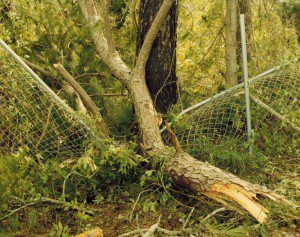
There were 112 downed trees at the IPPL sanctuary after the hurricane struck.
A walk round the grounds showed that about 112 trees had come down, many landing on our perimeter fences and on all the otter pens. Many other trees were leaning at precarious angles, and there was debris all over the place. Fortunately none had fallen on the old house or the new partly-constructed office building. Both driveways were completely blocked.
We felt terrible. No electricity! No running water! No phone! No refrigeration! No animal care staff! And no exit from our property!
In the mid-morning, we had a wonderful surprise. Our friend Robin Pringle arrived from Ellabell, Georgia, bringing with him his machete, several hand-saws, containers of drinking water, several rolls of fencing, and all kinds of goodies! Then the Summerville high school students showed up. An Air Force man came with a chain-saw and worked for ten days clearing the fallen trees off the fences. He found his way here by asking the sheriff, since all the street signs were down.
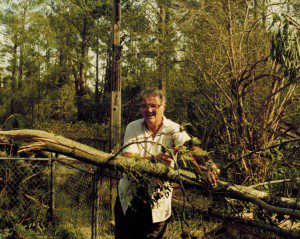
John McGreal was busy for weeks cleaning up after Hurricane Hugo.
It took a week to locate a generator so we could finally get the wells running and clean the gibbon housing. Once the phone lines were back up, we received calls from all over the United States as well as from Japan, Thailand, and Qatar. We felt less alone. Slowly the animal care staff returned. Members started to send funds to help with repairs.
IPPL and all our precious animals had survived this monster storm. We considered ourselves fortunate.
